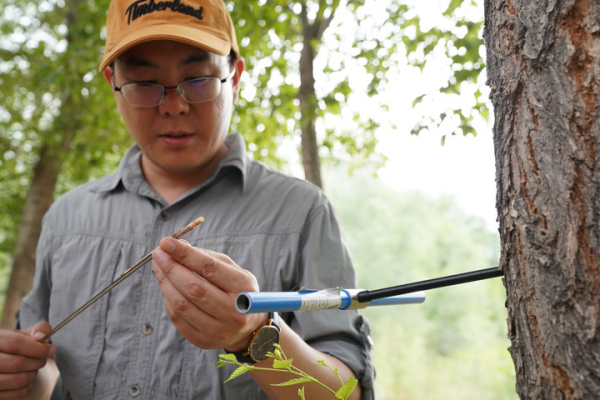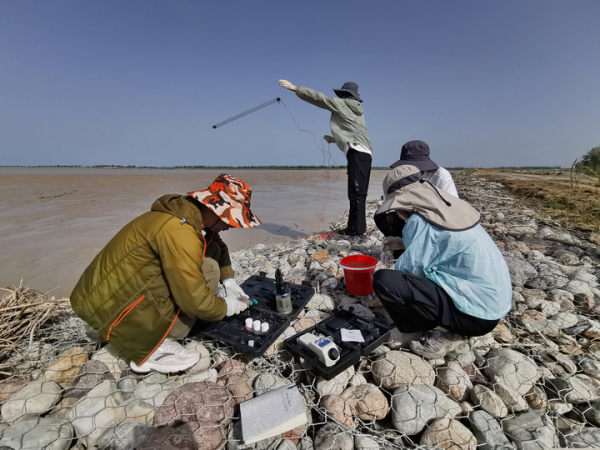In a shelterbelt forest on the northern slope of the Tianshan Mountains in northwest China's Xinjiang Uygur Autonomous Region, Jia Xiaoxu is drilling the core of a poplar tree.
Jia Xiaoxu, a researcher from the Chinese Academy of Sciences (CAS), is the project leader in the investigation and evaluation of the desert vegetation and the shelterbelt forests on the northern slope of the mountains during the ongoing comprehensive ecological survey in Xinjiang.
When a stream of liquid flows from the poplar tree, he observes the color of the liquid and smells it closely.
"Once the tree lacks water, its ability to resist drought will be weakened, which will lead to some insect-borne diseases," he said.
His team has investigated hundreds of shelterbelt forests in the region. The shelterbelt forest plays an important role in soil and water conservation, protection of farmland benefits, reduction in wind speed, prevention of wind and sand hazards, and conservation of biodiversity. It is of great significance to the ecology of neighboring cities.
"So far, the overall condition of shelterbelt forests in Xinjiang is relatively good, thanks to the ecological water replenishment," he said.
As the key area of high-quality development in Xinjiang, the area on the northern slope of Tianshan Mountains, including cities like Urumqi, Karamay and Changji, it's also an important area of the Silk Road Economic Belt. Jia hopes to come up with collaborative strategies and plans for both land development and ecological protection on the northern slope of the Tianshan Mountains, as well as plans for reducing soil, water and air pollution during the survey.

Researcher Jia Xiaoxu drilling the core of a poplar tree in Xinjiang, July 29, 2023. /CAS
Researcher Jia Xiaoxu drilling the core of a poplar tree in Xinjiang, July 29, 2023. /CAS
Not only on the northern slope of the Tianshan Mountains, the ecological survey has also been carried out in the Tarim River, the Ili River, the Irtysh River and the Turpan-Hami basins.
The survey was launched in 2021 and is expected to last for five years, aiming to resolve the prominent contradiction between ecological and economic development that hinders Xinjiang's high-quality development and to provide a roadmap for ecological construction and green development in the region in the next 30 years.

Surface water detection and sampling carried out at the source of the Tarim River in Xinjiang, August 2, 2023. /CAS
Surface water detection and sampling carried out at the source of the Tarim River in Xinjiang, August 2, 2023. /CAS
On the southern slope of the Tianshan Mountains, the Turpan-Hami Basin's observed surface temperature reaches 59 degrees Celsius.
Under a scorching sun, Wang Jinjie, a researcher at Xinjiang University, is conducting a water resources survey in the basin.
"This basin is a typical arid area, and its ecological environment is extremely sensitive to climate change and human activities," she said.
"The comprehensive water resources survey can provide data basis for accurate prediction of future climate and assessment of water resource risks, as well as a scientific basis for achieving sustainable development in arid areas," she added.
So far, the ecological survey in Xinjiang has lasted for nearly two years and has made some progress.
"The survey uncovered some new available water sources in Xinjiang, and some new species were discovered," said Zhang Yuanming, director of the Institute of Ecology and Geography at CAS.
During the survey, new technical means such as drones and satellite remote sensing have been used to investigate areas that lacked data before and uninhabited areas.
In the Turpan-Hami Basin, a team from Beijing Forestry University conducting a survey of biodiversity and biological resources with special resistance (e.g. anti-salt, anti-drought and anti-radiation) found new microorganism species with resistance in places like deserts and salt lakes. Also, the number of wild camels and their habitat area have increased in the basin.
(If you have specific expertise and want to contribute, or if you have a topic of interest that you'd like to share with us, please email us at nature@cgtn.com.)